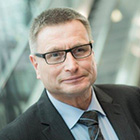

The New Industrial Revolution
By Sarah Karlen
As a relatively new concept that has potential to transform companies, The Industrial Internet of Things (IIoT) connects people, data, and intelligent machines to enable productivity and efficiency for a new era of economic growth. Stripped down to the purest meaning, the Industrial Internet of Things means innovative technology creating more value and growth for companies around the world. Not only will this significant trend boost user-machine interaction, but it will also revolutionize M2M (machine-to-machine) engagement, creating new opportunities to improve customer experiences, operational insight and productivity, predictive maintenance, safety, and more.
IIoT may seem ambiguous to many because it is a new, uncharted territory. But the potential for big returns on IIoT investment is there. By some estimates, the industrial internet could add some $14 trillion in to the global economy by 2030. For this reason, BPI Network is teaming with Penton Media’s new IoT Institute to flesh out the strategy and details of how organizations can measure value and growth within this domain. The BPI Network is pioneering groundbreaking research that seeks to understand the actual business worth created from operational insight of the Industrial Internet of Things. BPI’s new initiative “The Impact of Connectedness on Competitiveness” engages with manufacturers, plant operators, infrastructure managers, and transportation providers to understand where these businesses are in adopting IIoT.
While the results of a global survey of business executives will not be released until later in October, preliminary findings show that a sizable 70 percent of executives expect major economic impact from IIoT over the next three years. Nevertheless, less than 8 percent of organizations say they have a clear vision for IIoT with implementation of applications underway. Over 60 percent of respondents see IIoT as a high or growing strategic area of interest, and because IIoT is still in early exploration, there are ample opportunities to create business value from creating applications and strategies tailored to each industry. The new study will properly equip businesses with guidance on using IIoT applications and benchmark the degree to which smart operational management is enabling new business models.
If you have not already, participate in the survey here.
The Business Performance Innovation (BPI) Network’s partner for this initiative, Penton’s IoT Institute was launched just this year in recognition of the huge opportunity presented by IoT. The Institute is dedicated to providing real-world case studies, insights, research and E-Learning on this new phenomenon that is reshaping businesses and cities today. Penton is focused on getting beyond the ‘hype’ and provides advice on how to evaluate the importance of technology for each unique business and best execute project deployments. Penton’s mission is to aid cross-industry learning and partnership to catapult IoT market value.
A common misconception workers have of IIoT is that their value could decrease as an employee if there are smart machines ‘replacing’ them. That being said, in Spring 2016 the IoT Institute conducted a survey measuring the primary advantages IIoT is bringing to different industries. In the Manufacturing field, research shows that only 2 percent of businesses consider a primary advantage of leveraging IoT to be reducing headcount. Rather, these businesses are looking to utilize IoT for improved data analytics and services (53 percent) and improved workflow and processes (49 percent).
Chief Marketing Officer at IDG (International Data Group), Josh London, agrees: “We are not a room full of servers run by an algorithm that creates the best solutions for people. It is still very much about the individuals, and their ability to meld art and science together that really makes the difference here.” IIoT plays a powerful role in transforming the future, but that still cannot be done without the hard work of committed employees.
Indeed, executives from leading companies indicate that education is critical to the IIoT revolution, and BPI Network’s research initiative will thoroughly explore what will reduce risk and maximize uptime, safety, comfort, output, as well as further efficiencies and cost reductions. Peter Trebilcock, Director of BIM at Balfour Beatty, emphasizes the importance of education in this new, technological world: “In the marketplace, there is still a fundamental lack of understanding and appreciation in changing from the status quo when it comes to digital and technological transformation. There are certainly specific concerns around skills and standardization, specifically around aligning your digital approach with suppliers and field teams.”
Even machines still need proper education, and Trebilcock believes that the real gold lies in terms of machine learning and analytics to use data that has been generated to learn about the small negative outcomes. Positive feedback is always helpful, but the negative outcomes are where companies will truly know where and how to grow. “It’s not just about connecting pieces of a building together through digital construction though; it is also about being able to optimize construction and minimize waste, energy usage and risk, and make it the leanest and safest project possible,” states Trebilcock.
Once companies grasp the evolving concept of IIoT, the transition is smooth and the outcomes are successful. “Thanks to IoT, we are shifting from a product-centric to a service centric industry,” says Kalman Tiboldi, Chief Business Innovation Officer at TVH. “Now, we can connect with and measure the usage of our assets and devices. We get value from IoT in many different ways; from having sensors in the right place and leveraging value from the data, it creates incremental improvements to both efficiency and safety.”
Chief Marketing Officer at SAP, Maggie Chan Jones, believes that now more than ever, companies should utilize their advanced technology: “We could potentially even get live data to show whether you are going to have a big hit on your hands, or whether you have to make some adjustments along the way. We have the chance to be a lot more agile because we can launch something and continue to iterate on it.”
Partnering with Penton’s IoT Institute, the BPI Network will launch its research study, “The Impact of Connectedness on Competitiveness” in early October. Those findings will be further fleshed out at feature panel discussions and an executive roundtable at Penton’s IoT Emerge Conference in November. The Chicago based conference will include working sessions, keynotes, workshops, live demonstrations, hands-on training, and peer-to-peer networking.
IoT Emerge displays IoT innovators that are reorienting their thinking and successfully addressing organizational readiness, data analytics, security best practices, and sensor-based networks. The new Industrial Revolution has arrived. Are you ready?



 Share
Share

